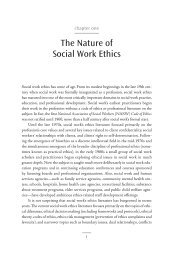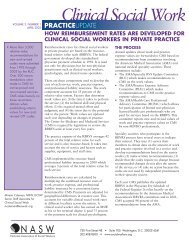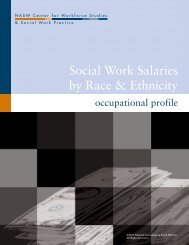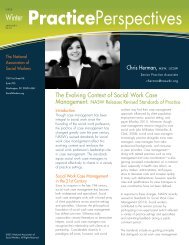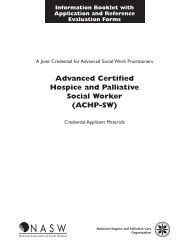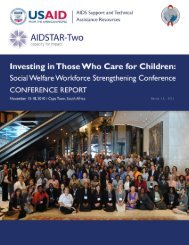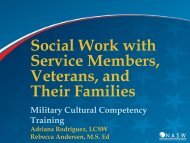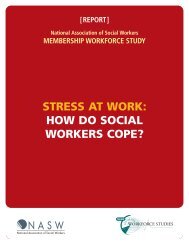Social Workers in Schools - Center for Workforce Studies - National ...
Social Workers in Schools - Center for Workforce Studies - National ...
Social Workers in Schools - Center for Workforce Studies - National ...
You also want an ePaper? Increase the reach of your titles
YUMPU automatically turns print PDFs into web optimized ePapers that Google loves.
N A S W C e n t e r f o r W o r k f o r c e S t u d i e s<br />
& S o c i a l W o r k P r a c t i c e<br />
<strong>Social</strong> <strong>Workers</strong> <strong>in</strong> <strong>Schools</strong><br />
(K<strong>in</strong>dergarten through 12th Grade)<br />
occupational profile<br />
©2010 <strong>National</strong> Association of <strong>Social</strong> <strong>Workers</strong>.<br />
All Rights Reserved.
Overview<br />
School social workers play a critical role <strong>in</strong> schools and educational sett<strong>in</strong>gs. <strong>Social</strong> workers work<strong>in</strong>g with<strong>in</strong> school systems<br />
provide services to students to enhance their emotional well-be<strong>in</strong>g and improve their academic per<strong>for</strong>mance. School social<br />
workers are usually employed by the school district or an agency that is contracted with the school district to provide<br />
services. School social workers are often called on to help students, families, and teachers address problems such as<br />
truancy, social withdrawal, overaggressive behaviors, rebelliousness, and the effects of special physical, emotional, or<br />
economic problems (Barker, 2003). School social workers often also address issues such as substance abuse and sexuality<br />
issues <strong>in</strong> the higher grade levels.<br />
Overview of Functions<br />
School social workers have a wide range of job functions. Their title is typically “school social worker.” Qualifications<br />
<strong>for</strong> this position are often decided by the school district or employ<strong>in</strong>g agency and requirements can range from a<br />
bachelors degree to a cl<strong>in</strong>ical license from the state <strong>in</strong> which they practice. Below is a list of possible job functions<br />
with<strong>in</strong> a school sett<strong>in</strong>g.<br />
occupational profile<br />
■<br />
■<br />
■<br />
■<br />
■<br />
■<br />
■<br />
■<br />
■<br />
■<br />
■<br />
■<br />
Conduct<strong>in</strong>g bio-psychosocial assessments and social histories;<br />
Assess<strong>in</strong>g students <strong>for</strong> substance use, support systems, physical and emotional function<strong>in</strong>g, barriers to academic<br />
per<strong>for</strong>mance, peer issues, suicidal/homicidal ideation, and similar issues;<br />
Develop<strong>in</strong>g and implement<strong>in</strong>g treatment plans and discharge plans that support student self-determ<strong>in</strong>ation;<br />
Provid<strong>in</strong>g direct therapeutic services such as <strong>in</strong>dividual, family or group therapy regard<strong>in</strong>g specific issues;<br />
Provid<strong>in</strong>g crisis management services, <strong>in</strong>clud<strong>in</strong>g assess<strong>in</strong>g <strong>for</strong> safety;<br />
Advocat<strong>in</strong>g <strong>for</strong> student services and students’ best <strong>in</strong>terests;<br />
Provid<strong>in</strong>g case management services <strong>in</strong>clud<strong>in</strong>g, but not limited to, referrals to community resources, collaboration<br />
with other professionals;<br />
Provid<strong>in</strong>g tra<strong>in</strong><strong>in</strong>gs and workshops to teachers, school staff and parents;<br />
Conduct<strong>in</strong>g home visits;<br />
Identify<strong>in</strong>g and resolv<strong>in</strong>g ethical issues;<br />
Manag<strong>in</strong>g and supervis<strong>in</strong>g staff; and<br />
Contribut<strong>in</strong>g to a multidiscipl<strong>in</strong>ary treatment team.<br />
1
Benefits and Challenges of Work<strong>in</strong>g as a<br />
School <strong>Social</strong> Worker<br />
School social workers play a vital role <strong>in</strong> address<strong>in</strong>g the various needs of students <strong>in</strong> an educational sett<strong>in</strong>g. Through the<br />
roles social workers assume, they have the opportunity to collaborate <strong>in</strong> the improvement of the lives of those they serve.<br />
<strong>Social</strong> workers who provide mental health services are required to be licensed by the state <strong>in</strong> which they practice. Their<br />
roles can vary from student to student, provid<strong>in</strong>g a variety of experiences on a daily basis. However, like many social<br />
workers, the caseloads of school social workers are often high. School social workers can be assigned to more than one<br />
school, requir<strong>in</strong>g time to travel between locations. Often the school social worker per<strong>for</strong>ms <strong>in</strong> isolation and may not have<br />
access to consistent supervision. There also may be limited resources to support service delivery such as a lack of<br />
confidential and private space, supplies, and tra<strong>in</strong><strong>in</strong>g.<br />
REFERENCES<br />
Barker, R. (2003). The <strong>Social</strong> Work Dictionary. (5 th Edition). Wash<strong>in</strong>gton, DC: NASW Press.<br />
Data referenced <strong>in</strong> this profile are based upon results from the 2009 NASW Salary & Compensation Study (see Notes).<br />
Salary Analysis of <strong>Social</strong> <strong>Workers</strong> <strong>in</strong> School Sett<strong>in</strong>gs, K-12th<br />
Grade (n=1,358)<br />
ANNUAL SALARY BY AGE 1<br />
1<br />
Your age (under 25; 25-29 30-34; 35-39; 40-44; 45-49; 50-54; 55-59; 60-64; 65 and older)<br />
2<br />
<strong>Social</strong> <strong>Workers</strong> <strong>in</strong> <strong>Schools</strong>
ANNUAL SALARY BY YEARS OF EXPERIENCE 2<br />
ANNUAL SALARY BY DEGREE 3<br />
occupational profile<br />
2<br />
In what year did you first beg<strong>in</strong> work<strong>in</strong>g <strong>in</strong> the social work field<br />
3<br />
Which of the follow<strong>in</strong>g academic degrees do you hold (if any)<br />
3
ANNUAL SALARY BY CERTIFICATION 4<br />
ANNUAL SALARY BY CERTIFICATION (CONTINUED)<br />
<strong>Social</strong> <strong>Workers</strong> <strong>in</strong> <strong>Schools</strong><br />
4<br />
In which of these areas (if any) do you hold current certifications Please check all that apply.<br />
4
ANNUAL SALARY BY SECTOR 5<br />
occupational profile<br />
ANNUAL SALARY BY PRACTICE AREA 6<br />
5<br />
On October 1, 2009, what was the sector of your primary social work position<br />
6<br />
Which one option best matches the primary practice area of your primary position (Please check the one best option.)<br />
5
ANNUAL SALARY BY REGION 7<br />
ANNUAL SALARY BY CENSUS REGION<br />
<strong>Social</strong> <strong>Workers</strong> <strong>in</strong> <strong>Schools</strong><br />
7<br />
On October 1, 2009, what was the city, state, and ZIP code of your primary work location<br />
6
ANNUAL SALARY BY CENSUS REGION (CONTINUED)<br />
occupational profile<br />
7
Survey Methodology<br />
This survey was sponsored and developed by NASW. Data were collected and tabulated by Readex Research, an<br />
<strong>in</strong>dependent research company. To broaden representation of the profession, NASW partnered with a number of other<br />
social work membership organizations to create an expanded list of U.S. professional social workers <strong>for</strong> sampl<strong>in</strong>g<br />
purposes. These partner organizations were:<br />
■<br />
■<br />
■<br />
■<br />
■<br />
Association <strong>for</strong> Oncology <strong>Social</strong> Work (AOSW)<br />
<strong>National</strong> Hospice & Palliative Care Organization (NHPCO)<br />
<strong>National</strong> Network <strong>for</strong> <strong>Social</strong> Worker Managers (NNSWM)<br />
The Rural <strong>Social</strong> Work Caucus<br />
Society <strong>for</strong> <strong>Social</strong> Work Leadership <strong>in</strong> Health Care (SSWLHC)<br />
The total number of unduplicated <strong>in</strong>dividuals among these five lists and the NASW domestic membership was 101,995.<br />
The overall sample size of 78,777 consisted of the 73,777 with a valid email address on file and a systematic sample<br />
of 5,000 (from the 28,218 who could not be reached via email).<br />
Data collection utilized a mixed mode approach. For those with a valid email address, <strong>in</strong>vitations were sent via email to<br />
access a Web-based survey. Those without an email address were sent <strong>in</strong>vitations via regular mail, with the option to fill<br />
out a provided paper survey or to access the survey onl<strong>in</strong>e via a provided Web site address.<br />
Data were collected between October 1 and November 24, 2009. A total of 23,889 unduplicated usable responses<br />
were received, <strong>for</strong> a 30% response rate. Among these, 22,000 responses were randomly chosen <strong>for</strong> <strong>in</strong>clusion <strong>in</strong> the f<strong>in</strong>al<br />
tabulation. The data have been weighted to account <strong>for</strong> disproportional response between the email and regular mail<br />
samples. Percentages based on all 22,000 responses are subject to a marg<strong>in</strong> of error of ±0.6%.<br />
RESPONDENT STATUS<br />
The compensation analysis focuses on the subset of “valid answer<strong>in</strong>g practitioners”—that is, U.S.-based respondents<br />
confirm<strong>in</strong>g paid employment or self-employment on October 1, 2009 <strong>in</strong> a social work-related position (def<strong>in</strong>ed as any<br />
position that requires or makes use of one’s education, tra<strong>in</strong><strong>in</strong>g, or experience <strong>in</strong> social work), and report<strong>in</strong>g regular salary<br />
or wages. Percentages based on these 17,851 “valid answer<strong>in</strong>g practitioners” are subject to a marg<strong>in</strong> of error of ±0.6%.<br />
Results are not shown <strong>in</strong> this profile if there were fewer than 30 valid values <strong>in</strong> a category.<br />
<strong>Social</strong> <strong>Workers</strong> <strong>in</strong> <strong>Schools</strong><br />
Removed are those who did not answer at all, those who provided a report considered to be an outlier (top 1% and<br />
bottom 1% of all responses), and those who did not answer <strong>in</strong> a coherent manner. The tabulated base of the<br />
“answer<strong>in</strong>g practitioners” is 17,911.<br />
8
NASW<br />
<strong>National</strong> Association of <strong>Social</strong> <strong>Workers</strong><br />
750 First Street NE, Suite 700<br />
Wash<strong>in</strong>gton, DC 20002-4241



